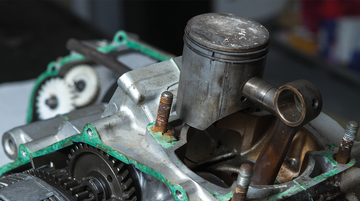
Der Kolbenbolzen ist ein unterschätztes Bauteil in deinem Motor. Damit du weißt was dahinter steckt und du deinen Motor besser verstehen kannst, widmen wir uns in diesem Beitrag dem kleinen aber überaus wichtigem Bauteil.
Funktion
Der Kolbenbolzen ist das Verbindungsglied zwischen Kolben und der Pleuelstange. Durch die lineare Bewegung des Kolbens und die Überlagerung von Gas- und Massenträgheitskräften ist er hohen Belastungen wechselnder Richtung ausgesetzt. An den Lagerstellen des Kolbens, in der Kolbennabe und dem kleinen Pleuelauge muss die Drehbewegung der Pleuelstange durch den Kolbenbolzen ausgeglichen werden.
Anforderungen
Kolbenbolzen müssen dabei folgende Anforderungen erfüllen:
- Sie sollten über eine ausreichende Festigkeit und Zähigkeit verfügen um die hohen Belastungen ohne Schaden zu ertragen.
- Um ein günstiges Verschleißverhalten zu erreichen, sollten Kolbenbolzen eine hohe Oberflächenhärte haben.
- Kolbenbolzen sollten eine hohe Form- und Lagetoleranz aufweisen um eine optimale Anpassung an die Kontaktflächen Kolben und Pleuel zu erreichen.
- Das Gewicht der Kolbenbolzen sollte so gering wie möglich sein, um zugleich die Massenträgheit geringer zu halten.
- Zur Vermeidung einer Überbeanspruchung in der Kolbennabe sollten Kolbenbolzen außerdem eine hohe Steifigkeit (einen hohen Widerstand gegen eine äußere Belastung) besitzen.
Nachfolgend noch einige zusätzliche Fakten zu den genannten Anforderungen:
Festigkeit
Aufgrund der einwirkenden Kräfte wird der Kolbenbolzen auf Biegen, Ovalisieren und Abscheren beansprucht. Infolgedessen besteht die Anforderung, dass der Kolbenbolzen möglichst steif und leicht sein sollte.
Deformation
Das kritische Bauteil der Kolbenverbindung ist nicht der Kolbenbolzen, sondern der Kolben. Ein Ovalisieren (= elastische Verformung) des Kolbenbolzen muss daher so gering wie möglich sein, da die ohnehin schon stark belastete Kolbennabe sonst überbelastet wird und es zu Nabenrissen kommen kann. Die Ovalisierung kann durch größere Kolbenbolzendurchmesser sowie einer Erhöhung der Wandstärke minimiert werden, was zu einer Erhöhung der Masse beiträgt.
Schmierung
Durch minimale Schmierung von 2-Taktmotoren wird die Verwendung von Nadellagern bei der Kolbenbolzenlagerung bevorzugt. Bei 4-Taktmotoren hat sich durch das vorhandene Spritzöl und die höheren Gaskräfte die Verwendung von Gleitlagern durchgesetzt. Öltaschen als Reservoir sind möglich, um den Aufbau eines Schmierfilms zu verbessern.
Werkstoffe
Kolbenbolzen werden aus Einsatz- und Nitrierstählen hergestellt. Das Härten ergibt bei guter Zähigkeit im Kern eine hohe Oberflächenhärte mit gutem Verschleißverhalten.
BARIKIT Kolbenbolzen
BARIKIT Kolbenbolzen sind in zwei Varianten erhältlich. Einmal mit einer zylindrischen Bohrung und einen gewichtsoptimierten Bolzen mit konischer Bohrung. Hier gilt es einen Kompromiss zwischen den Kolbenbolzen zu wählen, da beide Varianten Vorteile bieten. Der konische Bolzen ist mit seinem verringerten Gewicht optimal für Motoren, die auf höhere Drehzahlen ausgelegt sind. Diese Kolbenbolzen neigen allerdings zum stärkeren Ovalisieren als Kolbenbolzen mit zylindrischer Bohrung. Bei höheren Gaskräften kann dadurch die Kolbennabe stark belastet werden und im schlimmsten Fall zum Kolbenbruch führen. Deshalb sind Kolbenbolzen mit zylindrischer Bohrung für Motoren mit höheren Gaskräften und Drehmomenten geeignet. Wenn du dir unsicher bist, melde dich gerne bei uns per WhatsApp oder E-Mail. Unsere Kontaktdaten findest du unten. Wir beraten dich gerne.
